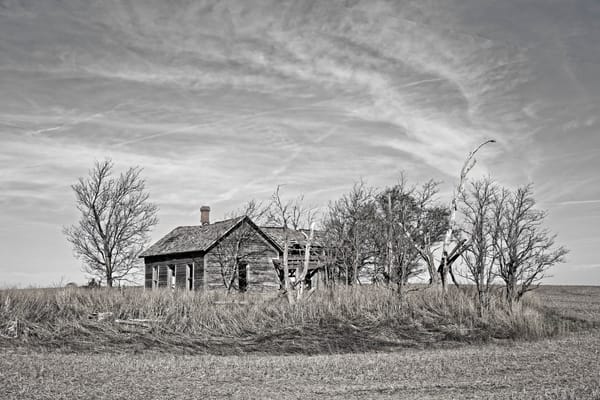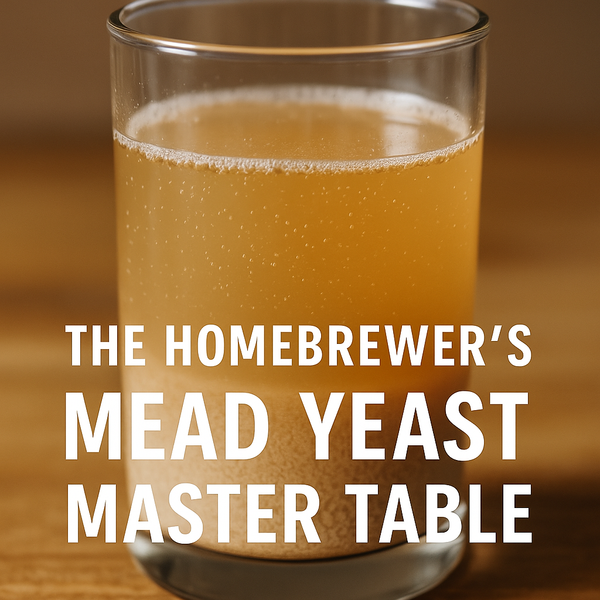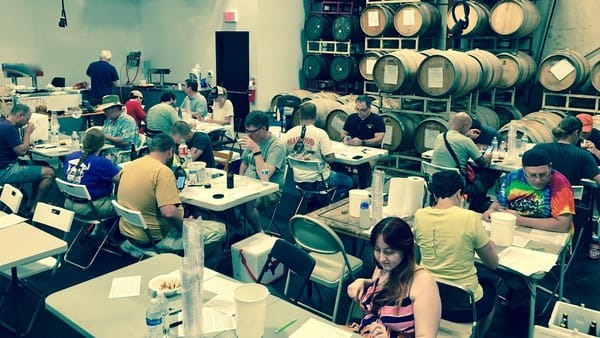My Typical Brew Day...

I'm posting my brewing process, more for myself than anything else. It is a good reference point to revisit over time, should certain habits or problems creep up. Brewing has become a ritual for me, something I can do that provides a lot of focused, refreshing concentration on something other than a computer screen full of email and spreadsheets!
Equipment:
- Brew-Magic V350MS - RIMS system, 1/2 barrel brewery. I got this because I wanted to brew right away, and not spend too much time tweaking and tinkering with a homegrown system. And it was gleaming... I like shiny things.
- Brew-Magic Chill-Wizard System - pump, plate chiller, and oxygenation stone all in a handy dandy installation.
- MoreBeer Ultimate Conical Fermenter - dual peltier coolers, heat belt, and temperature controls give me precise fermentation temperatures in the very HOT TEXAS HEAT
- Brew-Magic Fermenter & Select Sankey Keg - stainless fermenter and bright tanks. The challenge is temperatures without a cool room or basement. Love these things for secondary and long-term bulk conditioning.
- RO filter system - high flow rate so that I can prepare water the same day
- Monster Mill 2- Roller Mill - allows me to control my own crush and experiment with conditioning malt, different crush sizes for specific malts/grains.
- Better Bottles, buckets, etc.
- Homebuilt Stir Plate, 2L Erlenmeyer Flask, and a couple of 1g bottles
A typical brew day is planned. This is a critical step for me, especially when I am using a specific yeast. I almost always use a starter. I need to have my recipe planned out, ensure (and double-check) that I have all the ingredients, AND get the starter going. This is usually 48 hours in advance. I hope to catch the starter at high krausen or just after, and pitch at temperature into the chilled wort.
Setup and Procedure:
- Prepare water. I begin filling my HLT with water, reviewing the suggested amounts from my recipe (I use BeerSmith and occasionally iBrewMaster). I will take this time to weight out and add any phosphoric acid, calcium chloride and gypsum necessary to adjust my water. Some of that is scheduled for mash addition, some for HLT additions.
- I carefully weigh out my ingredients. I like to do the hops the night before, as I keep those frozen in vacuum bags. I will measure out - and put into numbered plastic cups. If there is room, seal those cups, otherwise, they are plastic wrapped and dropped into the freezer till use. For my malt - I weigh everything and mix into homer buckets for crushing.
- The exception is when I am using a larger or harder malt than my base malt, such as wheat. This I will keep and crush separately as I want to ensure the proper crush. If I crush huskless malted wheat at the same gap as my base malt, I am likely to need more rice hulls.
- Another exception is when I may not want roasted malts in the mash. If I am worried it will drive pH too low - then I will steep those separately and add to the mash at sparge.
- Heat the water. At this point, I move my strike water into the MLT and begin to heat it there directly and recirculate. This heats the system up so that temperatures stabilize more quickly at the desired temperatures. At the same time, I begin heating my sparge water to ~170° F. This allows me to top up the sparge water (also includes the Mash Out infusion water) and reserve some volume for rinsing/cleaning. My normal 11 gallon batches will use between 15 and 17 gallons of water, normally based on boil times. I multitask during these procedures to be efficient.
- Once the MLT water has reached the desired temperature (sometimes low for a protein rest or step mash) I will turn off the pump and fire and dough in. I am careful to fully mix in the grist to prevent any dough balls, although I have never seen this problem on the system. I will then turn on the pump and heat exchanger, and follow the lead of the system. Typically, I will need to direct fire for a few minutes at very low heat to help stabilize temps. I also restrict the flow significantly at this point to allow the grain to saturate.
- The Brew-Magic system uses a vinyl hose laid across the top of the mash to recirculate the hot wort. This means that the directly heated wort is immediately moved from below the mash in the false bottom, and pumped to the top. A whirlpool effect allows the solution to move continually through the grain bed. If you pump too fast too early - air and small unsaturated kernels can get into the plumbing and potentially stick.
- At this point, I set the timers and let it do its thing.
- I do check pH at 10 minute intervals to ensure optimal levels
- I will check gravity towards the end to ensure sweet wort has converted.
- I will occasionally do an iodine test, but usually use other senses (taste, smell)
- After 60 minutes, I generally Mash Out. I know that many people do not do this - however I have found that my beer has improved when I do this step, as well as my efficiency. On my system, I reset the temperature targets, direct fire the MLT and recirculate fully open. During Mash Out, I am also moving a Mash Out infusion into the MLT, which helps loosen up the mash allowing it to drain more smoothly. Typically, this will bring my MLT volume (with the grains) to about 14-15 gallons. I let this circulate for at least 10 minutes.
- Draining into the boil kettle. I stop the pump and any fire to the MLT
- I personally like smoother bitterness and have found FWH to be the key, especially for high-alpha hops... so whole hops into the kettle, pellet hops into a bag into the kettle.
- I drain the MLT completely. I know the Brew-Magic was designed to do a hybrid fly sparge, and I just am too impatient. I do a hybrid batch sparge and it has worked fine to keep my efficiency consistent, as well as allow me to get EXACTLY the right volumes into the kettle.
- As the MLT drains, I fire the boil kettle. This allows me to come to boil more quickly.
- Based on the amount in the kettle, I adjust my prepared sparge volume to match my required pre-boil volume (usually 12.5 g). I have previously calculated this and use little clamps on the site glass so that I can transfer liquor at a glance, but adjust for the recipe. I find that some malts (wheat) seem to absorb more liquor than others...
- Batch sparge. I typically only use a single batch when sparging. My MLT holds enough that multiple batches are not necessary. However, I do transfer the hot liquor over, then thoroughly mix, I then reset the transfer hose and circulate slowly until the wort clears. I maintain temperature through this process. I expect my pH to rise during this time, but not above 6. Then I shut off the pump and valves and drain the remaining into the boil kettle. Usually by the time this drains completely (watching the volume into the kettle closely and close the valve at 12.5 g), I am near boil temperatures and I am seeing hot break beginning to form. If I do not, I may add some calcium chloride into the BK.
- 60-90 minute boil. Nothing unusual here. I do tend to use some foam control agents as I boil very hard. The kettle holds 15.5 gallons and with the full boil, the roil can reach within the 14 gallon mark. I find the hard boil maximizes hot break and will only reduce boil to simmering for specific beers or times when I am concerned about melanoiden effects.
- I typically only do FWH and a 45 minute addition, then the rest are late additions (10-5 minutes)
- Sanitize the fermenter if it isn't ready yet
- Hop Stands. I use my Chill-Wizard pump to hop stand aroma/flavor additions in my APA and IPAs. Otherwise - will skip the hops, but use this time and process to begin to chill the wort.
- I am a huge fan of hop standing lots of hops for aroma and flavor. I think you get better dimensionality of flavors than just dry hopping alone.
- I recirculate through the plate chiller and out to the top of the kettle using one of the elbow fittings. At first, I leave the fire on for boil, and run this a few seconds. The chiller is (should be) clean from my last use, but I think this helps to sanitize any last bugs that might be hanging around. I do NOT run counterflow water at this point.
- I will also move this elbow into a suspended paint strainer to start collecting hot break. Then I turn off the fire.
- After 5 minutes or so, will start counterflow water. I don't worry too much about the ground water temperature, I am simply trying to cool the wort to 140° F quickly. This takes about 15-20 minutes in the heat of summer. Once we reach the stand temperature I stop the circulation and let things sit.
- Note, I do not oxygenate at this step, but do that as I transfer/chill to the fermenter
- Chilling. I generally have turned on my fermenter and started it cooling to pitch temperature before I start the hop stand. This combined with some ice water counterflowing as I transfer generally brings the wort close to pitching temps.
- I use the sintered stone plumbing on the Chill-Wizard with an oxygen tank and regulator during transfer. I am honestly not sure that is adequate oxygenation, but I go with it, plus a little splashing during the transfer.
- Using the ice water and VERY slow wort transfer, I can generally get down to about 75° F into the fermenter. I transfer with the same elbow connection through the top pipe of the fermenter, which causes some splashing as it flows.
- Once the volume is transfered, I let the fermenter bring the wort down to pitching temps. In the 110° F heat of Texas summer - this often takes a few hours.
- Pitch. Nothing special, just making sure temperatures and yeast volumes are correct.
- Dry Hopping. Whole hops in a bag, nothing special here either
- Yeast Harvesting. Something that I have the capability for, but haven't really explored heavily. I have the "yeast brink" unit that can be used to catch flocculating yeast during the chill down.
- I secondary in the Brew-Magic Fermenter or bright tank if required or holding the beer for extended conditioning or storage.
Cleaning.
Well cleaning sucks. Generally I wait to the following day, always risking the stinky smell of lacto fermenting grains. Lately - I have been doing a Clean in Place regiment, that can at least knock down cleaning times a bit - however I have to disassemble the system and do a full clean occasionally. There is just too much build up and gunk, as well as spills onto fire plates and frames.
- I run clean tap water into the HLT and start to heat it to about 150° F.
- I then wet vac out the mash, carefully cleaning the walls - get as much loose matter as possible.
- I then disassemble the internal diptube and false bottom, and pull them out to a bucket of cleaning water, and give them a good scrub.
- I wet vac out the bottom below the false bottom in the kettle, and give it a good scrub with PBW and water. I also scrub down the sides and under the lip and wet vac again. Also noting any possible scorch marks or stains that need to be dealt with.
- I reassemble the kettle and load in about 1g of tap water and bring to a boil.
- This will circulate through the system for about 5 minutes and then be drained out of the plumbing into a bucket. This helps release any gummy wort that is in the heat exchange and pump assembly.
- I then pump the 150° F water over from the HLT, and add the appropriate PBW or OxyClean and start to recirculate. This will go as long as necessary while I complete the same steps on the boil kettle. I reserve about 5 gallons in the HLT for a rinse.
- Once the boil kettle has been disassembled, cleaned and reassembled. I drain the MLT into the BK, and then drain the heat exchanger plumbing. This should remove the bulk of residual sugars, and help keep down stone from forming.
- I then use my hop stand procedure with the Chill-Wizard to recirculate the cleaning water through the BK, fittings, plate chiller and hoses. If the temperature is too low - will refire and heat the cleaning fluid back up.
- I rinse the plumbing using the reserved clean water in the HLT. This is pumped into the MLT and circulated until the rinse runs clear.
- I then pump the cleaning fluid from the BK into buckets or dispose into my flower beds. The PBW doesn't seem to bother my plants, but I try not to put the hot liquid directly onto any of them.
- The MLT clean water is then drained into the BK, splashed a bit to help rinse the sides, then goes out through the Chill-Wizard for disposal.
- I then drain the plumbing completely and button everything up for the next brew.
Whew. That was painful to edit. Not sure that Matt at Brew-Magic will approve of the brewing procedure, but it works and I get fairly consistent results. FYI - the V350MS is a dream to brew on - a great improvement over my DIY gear. I would highly recommend the system.




